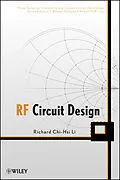A Must-Read for all RF/RFIC Circuit Designers
This book targets the four most difficult skills facing RF/RFIC
designers today: impedance matching, RF/AC grounding, Six Sigma
design, and RFIC technology. Unlike most books on the market, it
presents readers with practical engineering design examples to
explore how they're used to solve ever more complex problems. The
content is divided into three key parts:
* Individual RF block circuit design
* Basic RF circuit design skills
* RF system engineering
The author assumes a fundamental background in RF circuit design
theory, and the goal of the book is to enable readers to master the
correct methodology. The book includes treatment of special circuit
topologies and introduces some useful schemes for simulation and
layout.
This is a must-read for RF/RFIC circuit design engineers, system
designers working with communication systems, and graduates and
researchers in related fields.
Autorentext
Richard Chi-Hsi Li has designed RF/RFIC circuits at Motorola and other companies for more than twenty years. He has also taught a training course entitled "RF/RFIC Circuit Design."
Zusammenfassung
A Must-Read for all RF/RFIC Circuit Designers
This book targets the four most difficult skills facing RF/RFIC designers today: impedance matching, RF/AC grounding, Six Sigma design, and RFIC technology. Unlike most books on the market, it presents readers with practical engineering design examples to explore how they're used to solve ever more complex problems. The content is divided into three key parts:
-
Individual RF block circuit design
-
Basic RF circuit design skills
-
RF system engineering
The author assumes a fundamental background in RF circuit design theory, and the goal of the book is to enable readers to master the correct methodology. The book includes treatment of special circuit topologies and introduces some useful schemes for simulation and layout.
This is a must-read for RF/RFIC circuit design engineers, system designers working with communication systems, and graduates and researchers in related fields.
Inhalt
PREFACE.
PART I INDIVIDUAL RF BLOCKS.
1. LNA (LOW NOISE AMPLIFIER).
1.1 Introduction.
1.2 Single-Ended Single Device LNA.
1.3 Single-Ended Cascode LNA.
1.4 LNA with AGC (Automatic Gain Control).
2. MIXERS.
2.1 Introduction.
2.2 Passive Mixers.
2.3 Active Mixers.
2.4 Design Schemes.
3. DIFFERENTIAL PAIRS.
3.1 Why Differential Pairs?
3.2 Can DC Offset be Blocked by a Capacitor?
3.3 Fundamentals of Differential Pairs.
3.4 CMRR (Common Mode Rejection Ratio).
4. RF BALUN.
4.1 Introduction.
4.2 Transformer Baluns.
4.3 LC Baluns.
4.4 Micro Strip Line Baluns.
4.5 Mixed Types of Baluns.
5. TUNABLE FILTERS.
5.1 Tunable Filters in Communication Systems.
5.2 Coupling Between Two Tank Circuits.
5.3 Circuit Description.
5.4 Effect of Second Coupling.
5.5 Performance.
6. VCO (VOLTAGE-CONTROLLED OSCILLATOR)
6.1 Three-Point Type Oscillators.
6.2 Other Single-Ended Oscillators.
6.3 VCO and PLL.
6.4 Design Example of a Single-Ended VCO.
6.5 Differential VCO and Quad Phases VCO.
7. POWER AMPLIFIERS (PA).
7.1 Classifications of Power Amplifiers.
7.2 Single-Ended PA Design.
7.3 Single-Ended PA-IC Design.
7.4 Push-Pull PA Design.
7.5 PA with Temperature Compensation.
7.6 PA with Output Power Control.
7.7 Linear PA.
PART II DESIGN TECHNOLOGIES AND SCHEMES.
8. DIFFERENT METHODOLOGY BETWEEN RF AND DIGITAL CIRCUIT DESIGN.
8.1 Controversy.
8.2 Differences between RF and Digital Blocks in a Communication System.
8.3 Conclusion.
8.4 Notes for High-Speed Digital Circuit Design.
9. VOLTAGE AND POWER TRANSPORTATION.
9.1 Voltage Delivered from a Source to a Load.
9.2 Power Delivered from a Source to a Load.
9.3 Impedance Conjugate Matching.
9.4 Additional Effects of Impedance Matching.
10. IMPEDANCE MATCHING IN NARROW-BAND CASE.
10.1 Introduction.
10.2 Impedance Matching by Means of Return Loss Adjustment.
10.3 Impedance Matching Network Built of One Part.
10.4 Impedance Matching Network Built of Two Parts.
10.5 Impedance Matching Network Built of Three Parts.
10.6 Impedance Matching When ZS or ZL Is Not 50 .
10.7 Parts in an Impedance Matching Network.
11. IMPEDANCE MATCHING IN A WIDE-BAND CASE.
11.1 Appearance of Narrow- and Wide-Band Return Loss on a Smith Chart.
11.2 Impedance Variation Due to Insertion of One Part per Arm or per Branch.
11.3 Impedance Variation Due to the Insertion of Two Parts per Arm or per Branch.
11.4 Impedance Matching in IQ Modulator Design for a UWB System.
11.5 Discussion of Wide-band Impedance Matching Networks.
12. IMPEDANCE AND GAIN OF A RAW DEVICE.
12.1 Introduction.
12.2 Miller Effect.
12.3 Small Signal Model of a Bipolar Transistor.
12.4 Bipolar Transistor with CE (Common Emitter) Configuration.
12.5 Bipolar Transistor with CB (Common Base) Configuration.
